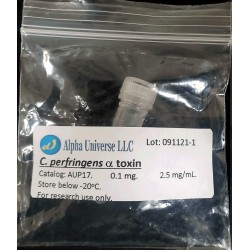Clostridium perfringens
Clostridium perfringens is a gram-positive anaerobic bacteria causing numerous gastrointestinal infections in most mammalian species. This microorganism can also cause diseases of skin, subcutaneous, and muscular tissues (gas gangrene or malignant edema). Most, if not all diseases produced by C. perfringens are mediated by one or more of its powerful toxins. Clostridium perfringens can produce up to 16 toxins in various combinations, including:
Alpha toxin is a 43 kDa protein. It contains two domains, an N-terminal domain which is a zinc-dependent phospholipase C, and a C-terminal domain which is involved in membrane binding. Alpha-toxin is a classic example of a toxin that modifies cell membranes by enzymatic activity. It degrades phosphatidylcholine and sphingomyelin, both components of eukaryotic cell membranes. Also, alpha-toxin activates several other membrane and internal cell mechanisms that lead to hemolysis.
Perfringolysin O, also called epsilon toxin, is an example of a sulfhydryl-activated toxin that causes cytolysis by forming pores in cholesterol containing host membranes. It is secreted as a prototoxin (32 kDa), which is converted into a fully active toxin (~1000 times more toxic than the prototoxin) when activated by proteases such as trypsin, chymotrypsin, and a metalloproteinase named lambda toxin that is produced by C. perfringens. After binding to target membranes, the protein assembles into a pre-pore complex. A conformation change leads to insertion in the host membrane and formation of an oligomeric pore complex. Cholesterol may be required for binding to host cell membranes, membrane insertion and pore formation. This toxin is the third most potent clostridial toxin after botulinum toxin and tetanus toxin, with a mouse lethal dose of 100 ng/kg.
Iota toxin is a binary toxin. It is formed by two independent protein components that are not covalently linked, one being the binding component (Ib,100 kDa) and the other the enzymatic component (Ia, 45 kDa). Both components are required for biological activity. The iota toxin components are synthesized as inactive proteins and are proteolytically activated by trypsin or chymotrypsin, removing a 20 kDa N-terminal peptide from the binding component (80 kDa for the active form) and 9 to 11 N-terminal residues from the enzymatic component. Ib triggers the internalization of Ia into the cell by receptor-mediated endocytosis. The mature binding component recognizes a specific cell membrane receptor, heptamerizes and mediates the endocytosis of Ia molecules. The Ia possess ADP-ribosylation activity and modifies G-actin at Arg-177 resulting in depolymerization of actin filaments. The final result of this is a change in morphology (rounding); inhibition of migration and activation of leucocytes; inhibition of smooth muscle contraction; and impairment of endocytosis, exocytosis, and cytokinesis.





